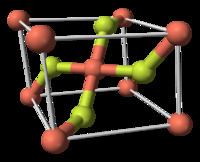Related compounds Melting point 836 °C Density 4.23 g/cm³ | Molar mass 101.543 g/mol Boiling point 1,676 °C | |
 | ||
Appearance White crystalline powderWhen hydrated Blue | ||
Copper(II) fluoride is an inorganic compound with the chemical formula CuF2. It is a white or green, crystalline, hygroscopic solid. It has a rutile-type crystal structure similar to other fluorides of chemical formulae MF2.
Contents
Structure
Copper(II) fluoride is made of a crystalline structure. It has a monoclinic crystal structure and can not achieve a higher-symmetry structure. It forms rectangular prisms and has parallelogram type base. It contains three vectors where one vector is perpendicular to two parallel vectors in the structure.
Uses
It has been shown that aromatic hydrocarbons react with copper(II) fluoride, in an oxygen-containing atmosphere at temperatures above 450 °C, to form fluorinated aromatic hydrocarbons. This reaction is simpler than the Sandmeyer reaction, but is only applicable for compounds that are stable enough to survive the high temperature.
Half mole of oxygen is used with 2 HF and Cu to make a mole of water and copper(II) fluoride.
Copper(II) fluoride can also be used to form fluorobenzene from benzene, HCl, and oxygen. Using a metal fluoride that can successfully oxidize with a methyl bond. The reaction is started by producing copper(II) fluoride with a charged metal reactor that contained copper oxide and then adding HF at high temperatures from there it is exposed to benzene and fluoroaromatics take place causing the formation of fluorotoluene or fluorobenzene or some other fluorinated benzene derivative. This enables fluoroaromatics to be done in large scale quantity without the waste disposals of the current fluorination processes.
Chemistry
Copper(II) fluoride can be synthesised from copper and fluorine at temperatures of 400 °C. It occurs as a direct reaction.
Cu + F2 → CuF2It loses fluorine in molten stage at temperatures above 950 °C.
2CuF2 → 2CuF + F22CuF → CuF2 + CuThe complex anions of CuF3−, CuF42− and CuF64− are formed if CuF2 is exposed to substances containing fluoride ions F−.
Solubility
It is slightly soluble in water but it starts to decompose when in hot water, to form basic F− and Cu(OH) ions.
Toxicity
Copper(II) fluoride together has not been researched well on toxicity levels. However the toxicity affect of copper compounds and fluoride compounds individually.
Copper can affect the skin, eyes, and respiratory tract. Some more serious conditions can occur such as metal fume fever, and hemolysis of the red blood cells. It can cause damage to the liver and other major organs as well.
Fluoride can cause nausea, vomiting, as well as causing upset stomach. More serious affects are weakness followed by tremors, problems breathing, serious convulsions and even coma. These can lead to brain and kidney damage. Chronic exposure can cause losses in bone density, weight loss, and on a more serious note even anorexia. It is also known to cause anemia and dental issues in some cases.
Hazards
When using copper(II) fluoride experiments should be conducted under a fume hood because metal oxide fumes can occur. If working with acids then the possibility of hydrogen fluoride forming may occur. A person should be cautious when dealing with hydrogen fluoride because it is highly toxic and corrosive.
